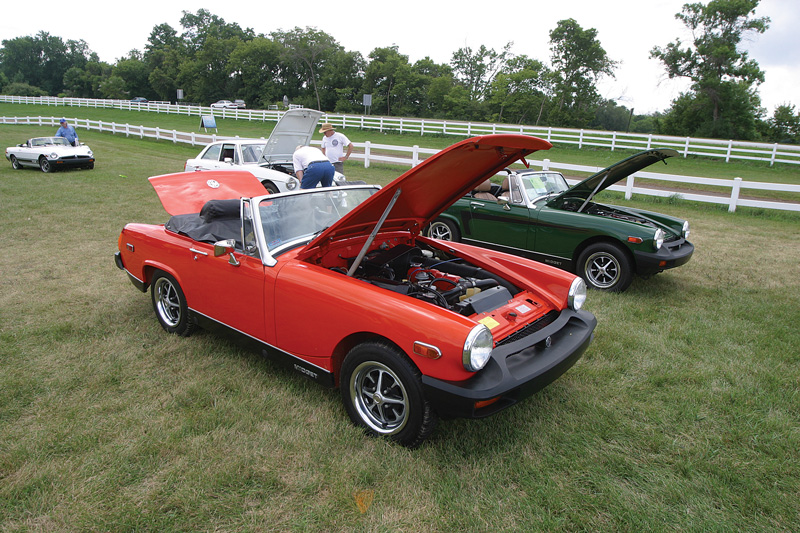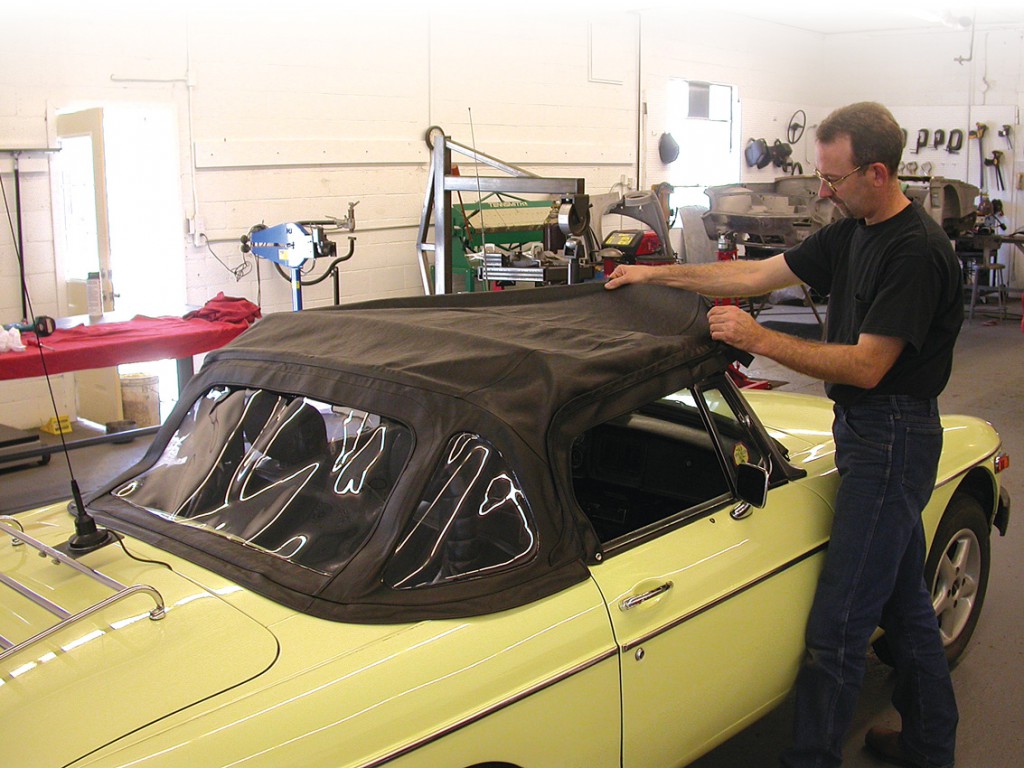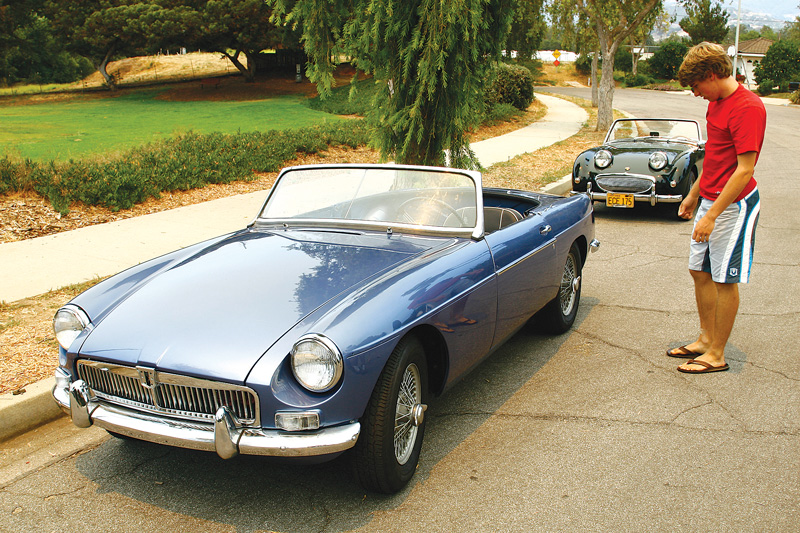 We constantly hear from people who want to buy a classic car. They yearn for that sports car experience—a curvy road, a humming engine and a nice day to put the top down. Some want to do a frame-up restoration including windshield repair and transmission overhaul, while others just want a play car to take to shows. Those who decided to restore a Toyota vehicle should look for a supplier of authentic parts, as well as a shop that offers Toyota windshield replacement services.
We constantly hear from people who want to buy a classic car. They yearn for that sports car experience—a curvy road, a humming engine and a nice day to put the top down. Some want to do a frame-up restoration including windshield repair and transmission overhaul, while others just want a play car to take to shows. Those who decided to restore a Toyota vehicle should look for a supplier of authentic parts, as well as a shop that offers Toyota windshield replacement services.
Perhaps it’s a father who wants to teach his teenaged son about mechanics by rebuilding a car, or a retiree who wants to tinker in the garage. These enthusiasts-in-the-making all seek the answer to the same question: Which car to buy?
For first-time British car owners, the experts at Moss Motors recommend three classic sportsters: the MGB, Triumph Spitfire 1500, and square-body MG Midget and Austin-Healey Sprite, called Spridgets since they’re nearly identical twins. All three models capture the essence of the British sports car experience and can be pain-free classics.
 Tops go down, heads turn thanks to their classic style and they’re good fun to drive. They also offer a low center of gravity, tight handling and an active driving experience. Oh, and they get good gas mileage and won’t take up an entire garage. History buff? You’re in luck; all have an impressive racing heritage.
Tops go down, heads turn thanks to their classic style and they’re good fun to drive. They also offer a low center of gravity, tight handling and an active driving experience. Oh, and they get good gas mileage and won’t take up an entire garage. History buff? You’re in luck; all have an impressive racing heritage.
This trio also offers great value. Thanks to high production numbers, all are readily available even though production ended decades ago. You can still find a decent project car for $1,500 or less.
 And once you acquire your project, all three cars are easy to fix, rebuild and restore yourself. Simple mechanical and electrical systems mean even novice mechanics can understand the diagrams. For complicated repairs like windshield repair or transmission overhaul, you may need to seek assistance from an auto mechanic.
And once you acquire your project, all three cars are easy to fix, rebuild and restore yourself. Simple mechanical and electrical systems mean even novice mechanics can understand the diagrams. For complicated repairs like windshield repair or transmission overhaul, you may need to seek assistance from an auto mechanic.
In addition to repair and restoration, it’s also easy to upgrade and personalize the three cars on our list. Rev up your roadster with some bolt-on speed parts. For a sharper look, install specialty wheels; for safety, try a roll bar.
So if you want to get off the fence and join the British car hobby—or would like to get another person involved—here are three great cars worth a serious look.
Moss Motors: Keeping Classics on the Road
Moss wants to help you keep these cars on the road, so they offer competitive prices, seasonal sales and Web specials. You can qualify for the Moss Customer Loyalty Program when you place a parts order at list price for at least $1,500. You’ll get a 10 percent discount on that order and all orders for a full year (some restrictions apply). You’ll get a dedicated salesperson who will be your personal project advisor throughout the restoration.
With a Spitfire, MGB or Spridget, you’ll also have plenty of support from dedicated clubs, enthusiast magazines and Web sites. You can participate in local club outings, car shows, national conventions, rallies, hillclimbs and event races. You’ll meet other owners who will be happy to share their knowledge and experience with you about these enduring classics.
 TRUSTY Twins: Austin-Healey Sprite and MG Midget
TRUSTY Twins: Austin-Healey Sprite and MG Midget
The post-Bugeye Austin-Healey Sprite and near-identical MG Midget, together known as Spridgets, make great sportsters for today’s enthusiast. The two cars have long been renowned for their affordability and easy repair. They were also sold in large quantities—some 300,000 units were built between 1961 and 1980.
An authentic driving experience is the key advantage of the Spridgets, says Blaine Graham, a Moss technical expert. They offer “bucket seats, a big tachometer, a big speedometer, four-on-the-floor and an engine that sends its rumbling sounds right through the firewall from under the bonnet,” he says. “In the Spridgets, you aren’t insulated from what’s going on. It’s not just a ride, it’s an experience.”
In a practical sense, Spridgets are relatively simple to work on and are usually quite forgiving when a novice is on the other end of the wrench, Graham adds. Parts availability is not a problem—Moss’ current Spridget catalog boasts 120 pages.
Larry Macy, a 29-year Midget veteran and one of the organizers of MG 2008, recommends looking for a 1966-’74 Spridget thanks to their 1275cc engine. “They’re easier to work on and aren’t clogged with pollution control equipment,” he says. Be aware that the transmission doesn’t have synchronized first gear prior to 1975, so you won’t be able to downshift from second without stopping first.
Macy adds that many owners complain of faulty wiring, but cleaning all the connectors and coating them with dielectric grease can prevent most problems.
Upgrades are just a phone call away. One of our favorites is Moss’ supercharger for the 1275cc engine. It’s probably the best bolt-on performance part ever made for these cars.
 Things to Know:
Things to Know:
• Spridgets received many improvements and changes over the years, with engine displacement constantly climbing: 998cc for 1961-’62; 1098cc for 1962-’65; 1275cc for 1966-’73; and the same 1498cc engine that Triumph used in the Spitfire for 1974-’80.
• When shopping for Spridgets, watch out for rust. Rusty lower sills are common and can hurt the rigidity of the body. Repair panels are available from Moss.
• Sprite production ended in 1971, while the MG Midget carried on until 1980.
• When car shopping, a non-operational engine isn’t terminal. If the engine turns over and hasn’t seized up, it can usually be brought back from its slumber.
• The basic shape of the Spridget didn’t change much over the years, although the 1972-’73 cars feature distinctive rear arches. Rubber bumpers first appeared in 1974 and continued through the end of production.
Fast Factoid: The only real differences between the Sprite and Midget twins are the vertically barred grille and chrome side strips found on the MG. Of course, the logos are different too.
Popular Upgrades
Moss sells heavy-duty valves for the original lever shocks. You can also go with a tube shock conversion kit, complete with new shock drop links.
Expect a 40 percent power increase when you install Moss’ supercharger on the 1275cc engine.
Heard horror stories about broken Spridget rear axles? Moss sells stronger rear axles. Choose from nitrited or heat-treated.
Moss offers five-speed gearbox conversions for all four engines found in the Midget. The kits use Ford’s popular T9 transmission and include all necessary parts.
 Quintessential Style: MGB Roadster
Quintessential Style: MGB Roadster
Timeless good looks, an uncomplicated nature and a lively ride mark the classic MGB. It’s like a best friend who’s always ready to play.
Nearly 30 years after production ended, the MGB is still one of the best-selling sports cars ever made. More than half a million units were produced between 1962 and 1980, and the company exported some 300,000 MGB roadsters to the U.S.
Today, good examples are easy to find at surprisingly affordable prices, while parts and upgrades are readily available. Like the other cars on our list, Moss has just about everything needed to keep an MGB in top form. The car’s fan support is off the charts.
The MGB wasn’t just a good, honest sports car—it represented a technical breakthrough, too. It introduced the monocoque chassis to mass market sports cars, as the body shell and frame were combined into one unit. Advantages include less weight than a traditional body-on-frame design, plus a stiffer overall unit. An MGB probably has more in common with the later Mazda Miata than most of its contemporaries.

Produced for nearly two decades, the MGB gives shoppers an array of choices, from a bare-bones early model to a more modern and sophisticated later edition.
Throughout its 18-year production run, the MGB used the same basic unibody, engine block, suspension and drivetrain. Compared to most other car models, changes were few.
But despite this, fans seem to have their favorite years. Some enthusiasts prefer the pre-1966 cars due to their door pull-handles, while others favor the 1965 and up cars due to their five main engine bearings. An all-synchromesh transmission, another desirable feature, appeared for the 1968 model year, yet so did emissions equipment and a less classic-looking padded dashboard—again, a plus came with a minus. Power started to slide as the 1970s progressed, yet some owners prefer the rubber-bumper cars that first appeared halfway through 1974. Yes, weight was up and power was down, but these cars are newer and can make great daily drivers.
The 1977 and up cars are desirable thanks to their updated dashboards.
Short answer: With so many MGB roadsters out there, one is right for you.
 Things to Know:
Things to Know:
• Cheerful in every color, the MGB is large enough to deal with modern traffic, and provide a roomy interior and a sizable trunk.
• One of the most significant changes came in 1965, as a five-main-bearing engine replaced the previous three-main-bearing motor. Overdrive was also offered as an option. This was the most powerful engine offered for North America, reaching 98 horsepower and 110 mph.
• More changes came for 1968: An all-synchromesh transmission was added, an alternator replaced the generator, and the electrical system was switched to negative ground. The first emission-control devices were also added. As emission requirements got tougher during the next few years, both the engine compression and horsepower dropped.
• Mid-1974 saw the biggest outward changes—the ride height was raised and black rubber bumpers were added to meet U.S. safety requirements. For 1975, a single Zenith-Stromberg carburetor replaced the dual SU units, dropping power to 62 horsepower. Production at the Abingdon factory ended in 1980.
Fast Factoid: Another MGB innovation when it was released in 1962: roll-up windows. Don’t forget, this was a big deal at the time.
Popular Upgrades:
The most popular upgrade is an electronic ignition, says Kelvin Dodd, a Moss technical expert. Up until 1976, MGBs had distributors fitted with points; after ’76 they had Lucas electronic ignitions that often failed. Moss carries Crane and Pertronix kits that make the car more dependable, Dodd explains.
Adding overdrive to the stock four-speed transmission can be expensive, but Moss offers a five-speed conversion kit that provides the benefits without the complexity.
For the finishing touch, Moss carries a leather seat kit, a cloth top and new wheels. Wire wheels come in original painted or chrome finish; conversion kits are available for later cars that originally came with steel disc wheels.
What’s the coolest MGB accessory? Moss’ air-conditioner kit. It’s designed for any 1962-’76 MGB. If your idea of cool is speed, there is Moss’ supercharger. Both add-ons can be installed with basic hand tools.
 TAKING NOTICE: Triumph Spitfire 1500
TAKING NOTICE: Triumph Spitfire 1500
The Triumph Spitfire was originally developed to compete against the Spridgets in the showroom and on the track. It succeeded in both arenas, dominating small-bore racing and selling well: 314,342 Spitfires were produced between 1962 and 1980.
Our favorites are the cars built from 1971 through 1980. They feature a re-designed rear suspension that eliminates some of the handling quirks found in the earlier swing-axle cars. You don’t have to peek under the car to determine if it’s fitted with the upgraded rear suspension. The chopped-off tail is the telltale sign.
These later Spitfires feature excellent handling, explains Moss technical specialist Ken Martin. The Spitfire has a low center of gravity and an independent rear suspension, making it a frequent autocross contender, he adds. Other advantages are its narrow body and light weight.
The Spitfire also gets high marks for its sheer aesthetics and comfort. Italian designer Giovanni Michelotti gave the car nice lines, as well as lots of legroom and trunk space.

Exceptional handling, timeless beauty and easy maintenance make the Spitfire an excellent first British car.
Wear watch: The rear leaf springs often weaken, resulting in negative wheel camber—replace them when needed. Watch for wear in the ball joints, crankshaft thrust washers, rear U-joints, and all the bushings for the suspension, steering rack and differential. When the grease fitting on the rear axle dries out, the rear wheel bearings freeze up and need to be replaced. If the rear differential oil dries out, you’ll hear a whining noise at the back end while driving.
Spitfires have been ignored by many for too long. Between the Italian-designed coachwork and handy flip-up front end, it’s definitely worth a look. BM
Things to Know:
• These 1971-and-up cars can be broken into two groups: The 1296cc-powered Spitfire Mk IV was sold from 1970 through 1974, while the appropriately named 1975-’80 Spitfire 1500 was powered by a 1493cc engine. The last-of-the-line 1979 and 1980 models, by the way, are easily identified by their all-black plastic bumpers.
• The entire front end can be unhinged and flipped forward. You can sit on the tire while you work on the engine.
• The body-on-frame construction makes it a great restoration car since it’s easy to replace body panels.
• Despite the swoopy look, the Spitfire shares much under-the-skin architecture with the Triumph Herald and Vitesse sedans.
• Looking to rack up some highway miles in a Spitfire? The factory-optional hardtop turns it into a coupe.
• While the 1493cc engine has more power than its predecessor, some enthusiasts prefer the revvy nature of the 1296cc powerplant.
Fast Factoid: Like the MGB and Spridgets, the Spitfire is still a popular contender at club racing events today.
Popular Upgrades:
One popular addition to the Spitfire 1500 is an oil cooler kit, says Bill Redman, a Moss Motors technical expert. A Hayden electric fan will provide better airflow, he adds.
Want to make the car even quicker in the turns? The factory raised the Spitfire 1500’s front suspension to meet then-current bumper and headlight rules. Moss offers a Lowered Fast Road Spring to correct this.
 Panasport eight-spoke wheels provide timeless looks without requiring a trip to the swap meet. Moss sells the 13×5.5-inch size for the Spitfire.
Panasport eight-spoke wheels provide timeless looks without requiring a trip to the swap meet. Moss sells the 13×5.5-inch size for the Spitfire.
Moss also offers a five-speed conversion kit for the Spitfires from 1970 and up. The package comes with everything you’ll need, such as the Ford T9 transmission, driveshaft, clutch kit, transmission tunnel cover and carpet.









'Three Great Cars for the First-Time Restorer' have 2 comments
March 1, 2017 @ 3:46 am Szan Hughes
I have a 68 trumph spitfire and want to up grade it to newer better performance can I just put a overdrive under the hood and change other things what do you recommend
December 20, 2018 @ 4:55 am Scott Jordan
What about the TR6? Is there something about the TR6 that makes it not ideal for a beginner? I am torn between a TR6 and the MGB. I love their bulldog looks. Spridgets and Spitfires just don’t interest me as much.
BTW, I am a total newb when it comes to cars. And I am totally ill-equipped for it. Very few sockets, no garage, no engine experience at all. I have driveway and an interest in learning, otherwise I am starting from scratch.
Oh, I have also not ruled out choosing the Chevy Corvair as my first project as it seats four and my wife and kids all love that. But yes, I understand that it is not as beginner-friendly as the MGB.